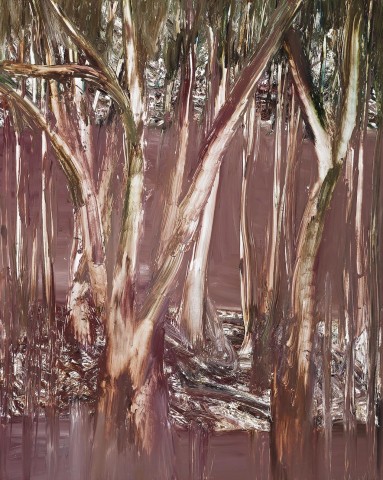RIVER BANK, 1965
SIDNEY NOLAN
oil on composition board
152.5 x 122.0 cm
signed and dated lower left: 18 Jan 1965 / Nolan
signed, dated and inscribed verso: E3033 / xREICHART [sic] / Nolan 18 Jan 1965 / … / 18 Jan 1965 / Nolan
probably: Marlborough Fine Art, London
Private collection, Melbourne
probably: Sidney Nolan: recent work, Marlborough Fine Art Ltd, London, May 1965, cat. 2
Riverbend I, 1964 – 65, oil on board, nine panels, 152.5 x 122.0 cm each, in the collection of the Australian National University, Canberra
From the earliest days of his painting career in the Wimmera, Sidney Nolan displayed a fascination with landscape in all its myriad forms. An inveterate traveller, he visited every continent, including Antarctica, and the resultant artworks captured an incredible variety of scenes. Through his study and understanding, these ever-changing lands became backdrops for his interwoven narratives, particularly those based around the legend of the Australian outlaw Ned Kelly. River Bank, 1965, is closely related to one of the most epic of these, Riverbend I, 1964 – 65 (Australian National University, Canberra), a nine-panel masterpiece set amidst the sodden, muddy banks of Victoria’s Goulburn River.
For Nolan, Kelly was something of a psychic doppelgänger, a flawed hero of grand ambition, class struggle, noble deeds and, for the outlaw at least, a tragic end. Such was his identification with Kelly that Nolan’s colleague Albert Tucker took to calling him ‘Ned’ in their correspondence. In the first Kelly series of 1945 – 47, the protagonist is in control of his lands, jaunty and all seeing. For the second series, painted during the mid-1950s after Nolan had first-hand experience of the devastation of post-war Europe, Kelly is shown wounded on a skeletal horse, navigating salt-pans as he seeks to evade capture. In the late 1950s, Nolan experimented with pigment mixed with polyvinyl acetate, applying it fluidly to his surfaces using squeegees, rags and fingers. He revisited this technique using oils instead of acrylic in Riverbend I, resulting in a paint application that is made deliberately visceral through vigorous brushwork with the outlaw and his pursuers mired in the result. ‘(H)ere is landscape as enclosing environment … beheld intently by Nolan who knits over and under surfaces so tightly that we are made aware of the microforms of the bush – the layered groves, its vegetable past – as well as the larger interchange of gum tree and undergrowth, dry bush and muddy river’.1 Nolan’s use of the Goulburn River as the setting for these works was tied to his own childhood memories of walking with his father along its inundated banks, past ‘a kind of billabong where the river winds round … very cool and (smelling) of tannin’.2
Nolan was renowned as an artist who would spend long periods contemplating and absorbing ideas before undertaking his projects in intense bursts of studio activity lasting for months. From August 1964, he painted approximately thirty large-scale ‘Kelly’ images – interspersed with others depicting Burke and Wills – before embarking on Riverbend I; and he continued on afterwards, full of bursting inspiration and ambition, before producing a second version of the masterpiece later in the year. The painting on offer here is one of the inter-connecting works and relates directly to panels two and four of Riverbend I, both of which feature a lagoon formed by flooding visible through the forest with two prominent trees (the trunks of which are near-identical to the ones in the painting on offer here) marking the submerged bank of the river. It is a vivid and authentically Australian vista, made all the more remarkable for having been painted in the artist’s studio in London by the expatriate artist whose imagination always retained the land of his birth.
1. Clarke, J., Sidney Nolan: Landscapes and Legends, National Gallery of Victoria, Melbourne, 1987, p. 12
2. Sidney Nolan, 1969, quoted in Pearce, B., Sidney Nolan, Art Gallery of New South Wales, Sydney, 2007, p. 55
ANDREW GAYNOR
